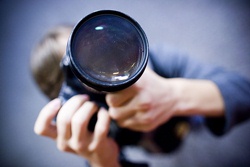I almost called this week’s column “Become a sharpshooter,” but decided that was just a little naff! Photographically speaking there is an enormous difference between sharp and soft. Those terms are the ones reserved for describing whether the final print is well focused. We speak about ‘sharp’ focus and ‘soft’ focus and everyone knows what is meant.

Forgetting all about Auto-Focus (AF) problems and camera shake for the moment, the deciding factor on whether or not you get sharp pictures will depend upon the quality of the optical glass in the lenses you use. Unfortunately quality costs money – like most consumer items. “You get what you pay for” works in photography just the same as it does in the red light areas!
I came across this fundamental truth when I was becoming despondent with the sharpness of my final prints many years ago. Even putting the camera on a tripod had not helped. Asking around in my photographer acquaintances led to my being loaned a very battered and well used Nikon FM2n, with a prime Nikon lens.
I took this “old” camera away and shot a multitude of photos. Off to the darkroom and guess what? Every one was as sharp as a tack. I had learned an important lesson and went and purchased some second hand Nikon equipment, and have never regretted it since. In fact, old FM2N Nikons were still part of my camera equipment until the digital revolution.
So what was the difference? Well, the end result will always rely on super sharp optics in the lens department. If they are not spot on, neither will your photos be spot on. The actual exposures are close enough for just about any camera these days with the latitude in the processors being so wide, so the other differences now will come down to ease of use, or user friendliness. Simple mechanical cameras, like the FM2, have simple operations too. These new electronic cameras with their “menus” and other operations I do not consider to be user friendly. It is easier to push a lever, surely. However, perhaps it might just be that I used to be resistant to change!
The important lesson from all that is that to get good results you need a camera that has good optics. There are plenty on the market these days, and although the Nikon brand may be my favorite, there are other manufacturers which have equally as good quality glass at the front. Unfortunately, the results from these great cameras can become poor if you put a cheap “after market” lens on it. Good lenses are expensive, but the end result is always worth it.
Having mentioned AF problems earlier, a few words on this again. While AF is now almost 100 percent universal, it still is not 100 percent foolproof. One of the reasons for this is quite simple. The camera’s magic eye doesn’t know exactly what subject(s) you want to be in focus and picked the wrong one! The focusing area for the AF system is a small circle or square in the middle of the viewfinder, so if you are taking a picture of two people two meters away, the camera may just focus on the trees in the far distance that it can see between your two subjects. Those trees are two km away, so you end up with a print with the background sharp and the two people in the foreground as soft fuzzy blobs. The fix is to focus on one person, use the ‘focus lock’ and recompose the picture.
Finally – camera shake. Cameras are supposed to be operated with two hands, not one. The practice of holding the camera in one hand and raising one, two and three fingers on the other can only lead to camera shake. Don’t do it. If you must tell your subjects that you are about to trip the shutter, do it by saying the words “one, two, three” – not by waving your fingers in the air.




